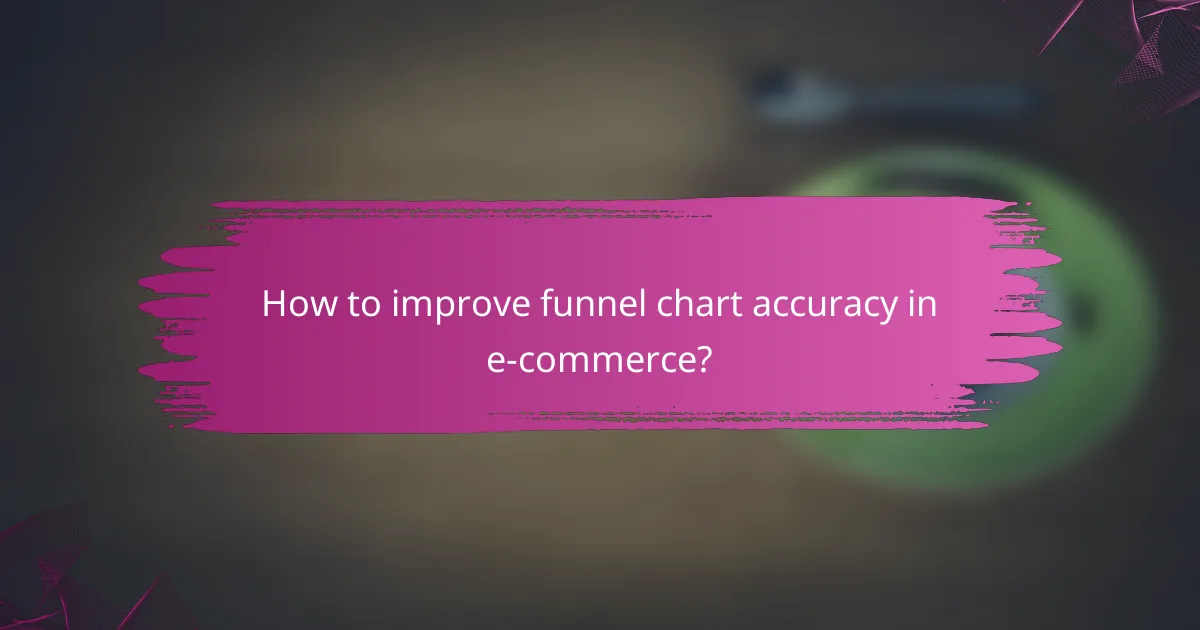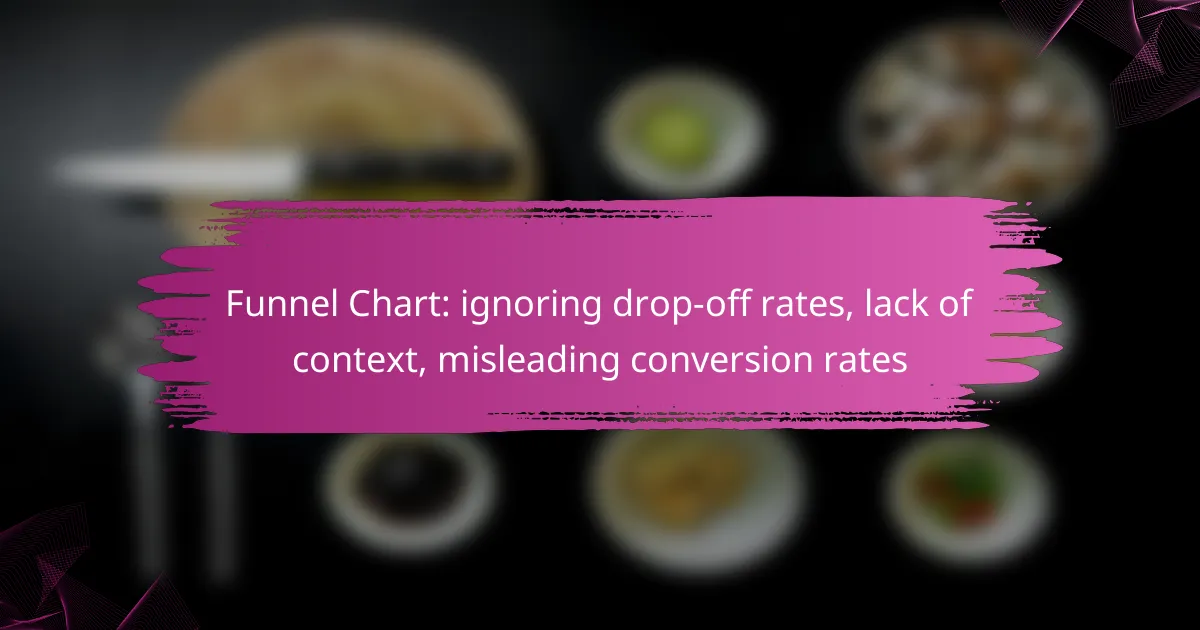Funnel charts are valuable tools for visualizing customer journeys, but they can be misleading if drop-off rates are ignored and context is lacking. Misinterpretation of conversion rates can lead to misguided strategies and ineffective decision-making. To enhance accuracy, it’s essential to analyze these factors and utilize advanced analytics tools that provide a clearer understanding of customer behavior.

How to improve funnel chart accuracy in e-commerce?
Improving funnel chart accuracy in e-commerce involves analyzing drop-off rates, providing contextual data, and utilizing advanced analytics tools. These strategies help create a clearer picture of customer behavior and conversion rates, leading to better decision-making.
Implement drop-off rate analysis
Drop-off rate analysis is essential for understanding where customers abandon the purchasing process. By tracking the percentage of users who leave at each stage of the funnel, you can identify critical points needing attention. For instance, if a significant number of users drop off during the payment stage, it may indicate issues with the payment options or user experience.
To implement this analysis, use tracking tools that allow you to visualize user paths through the funnel. Regularly review these metrics to pinpoint trends and adjust your strategies accordingly.
Provide contextual data
Contextual data enriches funnel charts by offering insights into external factors influencing customer behavior. This can include seasonal trends, promotional campaigns, or even economic conditions. For example, a spike in drop-offs during a holiday season might correlate with increased traffic but also with website performance issues.
Incorporate contextual data into your funnel analysis by using dashboards that combine funnel metrics with relevant external data. This holistic view can help you make informed adjustments to your marketing strategies.
Utilize advanced analytics tools
Advanced analytics tools can significantly enhance the accuracy of your funnel charts. Tools like Google Analytics, Mixpanel, or Kissmetrics provide in-depth insights into user behavior and conversion rates. They allow for segmentation of data, enabling you to analyze specific customer groups or behaviors.
When selecting a tool, consider factors such as ease of integration, cost, and the specific features that align with your business goals. Regularly leverage these tools to refine your funnel analysis and improve overall performance.
Conduct A/B testing
A/B testing is a powerful method for optimizing funnel performance by comparing two versions of a webpage or process. By testing different elements, such as button colors, copy, or layouts, you can determine which variations lead to higher conversion rates. This iterative approach allows for data-driven decisions rather than assumptions.
Set clear objectives for each test and ensure that you have a sufficient sample size to draw meaningful conclusions. Implement changes based on test results to continually enhance your funnel’s effectiveness.
Regularly update conversion metrics
Regularly updating conversion metrics is crucial for maintaining the accuracy of your funnel charts. As market conditions and customer preferences change, so too should your metrics. This may involve recalibrating your definitions of success or adjusting the time frames for analysis.
Establish a routine for reviewing and updating these metrics, such as monthly or quarterly assessments. This practice ensures that your funnel analysis remains relevant and reflective of current performance, allowing for timely adjustments to your strategies.

What are common pitfalls in funnel chart interpretation?
Common pitfalls in funnel chart interpretation include overlooking drop-off rates, lacking contextual understanding, and misinterpreting conversion rates. These issues can lead to misguided strategies and ineffective decision-making.
Ignoring drop-off rates
Ignoring drop-off rates can significantly distort the insights derived from a funnel chart. Drop-off rates indicate where potential customers lose interest or encounter obstacles, which is crucial for identifying areas needing improvement.
For example, if a funnel shows high initial interest but a steep drop-off in the middle stages, it suggests that the process may be too complex or unappealing. Addressing these drop-off points can enhance user experience and increase conversions.
Lack of contextual understanding
Lack of contextual understanding can lead to misinterpretation of funnel data. Without considering external factors such as market trends, seasonality, or user demographics, the insights drawn from a funnel chart may be misleading.
For instance, a sudden drop in conversions during a holiday season might not indicate a failure in strategy but rather a shift in consumer behavior. Always analyze funnel data alongside relevant context to make informed decisions.
Misleading conversion rates
Misleading conversion rates can arise from focusing solely on the final conversion figure without considering the entire customer journey. A high conversion rate may seem positive, but it could mask issues like low engagement or poor retention.
To avoid this pitfall, evaluate conversion rates in conjunction with other metrics such as customer lifetime value (CLV) and return on investment (ROI). This holistic approach provides a clearer picture of overall performance and effectiveness.

How to select the right tools for funnel analysis?
Selecting the right tools for funnel analysis involves understanding user needs, integration options, and visualization capabilities. Prioritize tools that simplify data interpretation and enhance decision-making.
Consider user-friendly interfaces
User-friendly interfaces are essential for effective funnel analysis. Tools should have intuitive designs that allow users to navigate easily and interpret data without extensive training.
Look for features like drag-and-drop functionality, clear labeling, and customizable dashboards. These elements can significantly reduce the learning curve and improve user engagement.
Evaluate integration capabilities
Integration capabilities determine how well a funnel analysis tool can work with your existing systems. Ensure the tool can connect seamlessly with your CRM, marketing platforms, and analytics software.
Check for compatibility with popular services like Google Analytics or Salesforce. A tool that integrates well can streamline data flow and provide a more comprehensive view of user behavior.
Assess data visualization features
Data visualization features are crucial for interpreting funnel metrics effectively. Look for tools that offer a variety of chart types, including funnel charts, bar graphs, and heat maps.
Strong visualization options help highlight trends and conversion rates clearly. Choose tools that allow customization of visual elements to suit your specific reporting needs.

What are the best practices for presenting funnel charts?
Effective presentation of funnel charts involves clarity, context, and actionable insights. By following best practices, you can ensure that your funnel charts accurately convey the conversion process and highlight critical performance metrics.
Use clear labeling and legends
Clear labeling and legends are essential for understanding funnel charts. Each stage of the funnel should be distinctly labeled to indicate what it represents, such as “Awareness,” “Interest,” “Consideration,” and “Conversion.” This clarity helps viewers quickly grasp the flow of users through the funnel.
Additionally, include a legend if your chart uses colors or patterns to differentiate stages. This will prevent confusion and enhance the chart’s overall readability, ensuring that stakeholders can interpret the data without misinterpretation.
Incorporate real-time data
Incorporating real-time data into your funnel charts allows for more accurate and timely insights. By using live data, you can reflect current user behavior and conversion rates, which can fluctuate frequently. This approach helps in making informed decisions based on the latest trends.
Consider using tools that automatically update your funnel charts with real-time analytics. This can help identify sudden drop-offs or spikes in user engagement, enabling you to react quickly to changes in user behavior.
Highlight key metrics
Highlighting key metrics within your funnel chart is crucial for drawing attention to the most important data points. Focus on conversion rates, drop-off percentages, and user counts at each stage. This emphasis allows stakeholders to quickly identify areas that may need improvement.
Using visual cues such as bold text or contrasting colors can help make these key metrics stand out. For example, if a particular stage shows a significant drop-off, use a red highlight to draw attention to it, prompting discussions on potential strategies for improvement.

How do funnel charts compare to other analytics methods?
Funnel charts provide a visual representation of the conversion process, highlighting the stages users go through before completing a desired action. However, they can be limited in context and may not fully capture user behavior compared to other analytics methods.
Funnel charts vs. cohort analysis
Funnel charts focus on the overall conversion rates across different stages, while cohort analysis breaks down user behavior over time, allowing for a more granular view of specific user groups. For example, cohort analysis can reveal how different segments of users perform during the same funnel stages, providing insights into retention and engagement.
When using cohort analysis, consider tracking metrics like retention rates and average revenue per user (ARPU) over defined time periods. This method can help identify trends and patterns that funnel charts might overlook, such as seasonal variations in user behavior.
Funnel charts vs. customer journey mapping
Funnel charts simplify the conversion process into distinct stages, whereas customer journey mapping provides a comprehensive view of all user interactions with a brand. Customer journey maps include touchpoints, emotions, and pain points, offering deeper insights into the user experience beyond mere conversions.
To effectively utilize customer journey mapping, gather qualitative data through user interviews and surveys. This approach can help identify barriers to conversion that funnel charts may not highlight, such as user frustrations or confusion at specific stages. Combining both methods can provide a fuller picture of user behavior and improve overall conversion strategies.

What emerging trends affect funnel chart usage?
Funnel charts are increasingly influenced by trends that highlight their limitations, such as ignoring drop-off rates, lack of context, and misleading conversion rates. Understanding these trends is essential for effectively interpreting funnel data and making informed decisions.
Ignoring drop-off rates
Many funnel charts fail to account for drop-off rates at each stage, which can lead to an incomplete understanding of user behavior. Ignoring these rates may result in overestimating conversion effectiveness, as it does not reflect the true user journey.
To address this, consider incorporating metrics that track user exits at each stage. This can provide a clearer picture of where users disengage, allowing for targeted improvements in the funnel process.
Lack of context
Funnel charts often lack contextual information that can significantly affect interpretation. Without context, such as user demographics or external factors, the data may mislead stakeholders about performance and effectiveness.
To enhance context, supplement funnel charts with additional data points, such as user feedback or market trends. This holistic approach can lead to more actionable insights and better decision-making.
Misleading conversion rates
Conversion rates displayed in funnel charts can be misleading if they do not reflect the entire customer journey. For instance, a high conversion rate at one stage may mask issues in earlier stages that could be causing drop-offs.
To avoid misinterpretation, calculate conversion rates based on a comprehensive view of the funnel, including all relevant stages. Regularly review these rates in conjunction with user behavior analytics to ensure they accurately represent performance.
